Information Technology Department, College of Computer and Information Sciences, King Saud University, Riyadh, Saudi Arabia
Article Publishing History
Received: 10/04/2019
Accepted After Revision: 20/06/2019
Saudi Arabia is one of the countries that suffer from the scarcity of water resources in the world. Due to the misuse of water resources, some sectors of our country face the danger of droughts. One such is agriculture. Plants require enough water resources to grow healthy and be fecund. Most previous researchers have focused on how to water plants depending on the time without checking whether the plants need watering or not. With the evolution of information technology, the Internet of Things (IoT) is one new technology, which can assist our country to reduce the overall impact of wrong water management in the agricultural sector. In this research, we focused on developing a smart irrigation control system (SICS) that only waters the plants when they need it, and can determine the exact amount of water con- sumed after each irrigation process. This system aims to help the homeowner by facilitating the process of watering the garden without involving any manpower.
Soil Moisture Sensor; Water Flow Sensor; Arduino; Irrigation System; Relay; Iot
Al-Zahrani S, Al-Baity H. H. Smart Irrigation Control System Using Internet of Things: An Empirical Study in Kingdom of Saudi Arabia. Biosc.Biotech.Res.Comm. 2019;12(2).
Al-Zahrani S, Al-Baity H. H. Smart Irrigation Control System Using Internet of Things: An Empirical Study in Kingdom of Saudi Arabia. Biosc.Biotech.Res.Comm. 2019;12(2). Available from: https://bit.ly/2YDcKiw
Copyright © Al-Zahrani and Al-Baity, This is an open access article distributed under the terms of the Creative Commons Attribution License (CC-BY) https://creativecommns.org/licenses/by/4.0/, which permits unrestricted use distribution and reproduction in any medium, provide the original author and source are credited.
Introduction
Home gardens play an important role and contribute significantly to giving an aesthetic and cultural appearance to the home. Studies have proven that just looking at plants will improve heart activity, muscle tension, blood pressure, and electrical brain activity. In addition, through colors and textures, a homeowner can feel calm, happy and satisfied (Siswazah, 2012). Furthermore, plants have evolved to be a form of treatment for the soul and body (Siswazah, 2012). One of the most important benefits of the home garden is increasing income, if it is exploited in a perfect and correct way. It gives homeowners immediate access to fresh fruit and vegetables, therefore, they do not need to visit a grocery store or farmers market to buy them. Water and irrigation are vital factors for preserving the home garden’s success.
Currently, water availability and irrigation management are challenges in the agricultural sector, especially in the Kingdom of Saudi Arabia. Saudi Arabia is located in one of the driest and hottest regions in the world. Furthermore, Saudi Arabia lacks permanent rivers and surface water. In addition, it suffers from climatological conditions, which are not environmentally ideal for agriculture (Roy & Ansari, 2014). Thus, to schedule irrigation properly, a homeowner must be aware of the environmental demands for surface water, which causes watering losses and consumes a lot of time and effort when processed manually.
Irrigation has been defined as “replenishment of soil water storage in plant root zone through methods other than natural precipitation” (Baig, et al., 2012). It began almost simultaneously in Egypt and Mesopotamia using the Nile river and Tigris and Euphrates rivers (Alkolibi, 2002). Irrigation is important in maintaining the landscape and reducing the effect of inadequate rainfall (Buechley & Hill, 2010). There are two kinds of irrigation: manual and automatic. Manual irrigation refers to a system that has the ability to water plants with human intervention and without technical equipment. Automatic irrigation is defined as a system that has the ability to water plants without human intervention and with technical equipments, (Li, et al., 2015 Javed 2016., Chandak et al., 2017).
Irrigation has been an important factor in agriculture since old times, where people used flooding rivers and tides to irrigate the plants. With the rapid growth of the population and the evolution of culture, these resources are no longer sufficient to meet the needs of human communities. Thus, they started to develop other irrigation methods that are based on enhanced techniques. With the evolution of information technology, the Internet of Things (IoT) is found in every industry with a variety of applications, one such is irrigation.
The IoT is defined as a technology that is used to connect things or objects with each other and allows the objects to collect and exchange data. The things or objects can be instruments, Radio-Frequency Identification (RFID) tags, cars, homes, sensors, and various artificial intelligence tools (Javed, 2016; Melorose, et al., 2015). The Internet of Things semantically means, “A worldwide network of interconnected objects uniquely addressable, based on standard communication protocols” (Melorose, et al., 2015). Many people think that the term “Internet of Things” refers to a new technology, however, the concept of IoT was developed from M2M communication (machine-to-machine communication), which was first used in telecommunications in 1999 by Kevin Ashton (Javed, 2016; Yao, et al., 2010). Currently, the IoT is widely used in various fields from remote
health management, alarm systems, transportation systems, and home automation, to smart cities and industrial IoT (Javed, 2016). One of the most important fields that utilize the IoT is agriculture, where it is used to connect objects with each other to water crops remotely in order to save time and effort (Yao, et al., 2010).
The purpose of this work is to develop a cost-effective Smart Irrigation Control System (SICS) to manage and organize water consumption, improving the effectiveness of soil protection by monitoring soil moisture. The remainder of this paper is organized as follows. In Section 2, we present an overview of the previous works related to solving the problem of irrigation systems. Section 3 describes the proposed methodology. Section 4 discusses how SICS was implemented. Section 5 provides a detailed description of the proposed approach and experimental results. Finally, Section 6 concludes this paper and discusses potential future work.
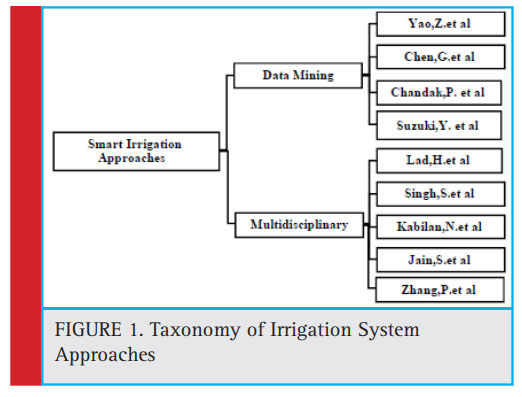 |
Figure 1 |
Related Work
A review of the literature shows that many studies have been conducted in the field of irrigation systems. Those studies were conducted using different approaches in order to provide more efficient and appropriate solutions to the irrigation problem. These approaches are: data Mining and multidisciplinary. The taxonomy below shows the classification we will follow in our review of the literature.
Data Mining Approach
The authors in (Yao, et al., 2010: Chen & Yue, 2011) aimed to apply the data mining algorithm Fuzzy Neural Network (FNN) to the irrigation system to determine the exact quantity of water required by different crops. FNN consists of fuzzy logic, which is used to provide thinking based on fuzzy rules for the neural network, and a neural network, which is used to provide a connection structure and learn-ing capability for fuzzy logic. The irrigation system works as follows: first, the system collects information about water and transmits this to a processing unit through the sensors. This information is then divided into ‘hunger’ and ‘thirst rate’ and transmitted to the fuzzy controller. The neural network performs self-learning on the results and specifies the water needs of the crops. The system has achieved high levels of success in determining the exact water needs of crops.
Chandak and Student (2017), have designed and developed a smart farming system based on data mining clustering techniques. The motive behind this study was to provide a better solution for growers to achieve high productivity. The data was gained from various resources such as satellite information, the internet, and soil testing reports. A clustering algorithm was used to partition the dataset into homogeneous groups based on similarities and dissimilarities, and decisions are based on awareness of weather changes. The use of this system was found to be effective at increasing the productivity of fields. Another study by (Suzuki, et al., 2013) focused on how to help novice users irrigate plants correctly. The authors proposed an agricultural cloud support system based on support vector machine (SVM), whereby data was collected for a week using different sensors: temperature, humidity, soil moisture, and sensing time. The data gained from the sensors was collected for six days for training phase and one day for testing phase. Then, SVM was applied for decision-making.
Multidisciplinary Approach
Lad.et al (2014) designed automated embedded systems and distributed them to different farms before developing a Controller Area Network (CAN) to connect these systems in order to improve the productivity of each crop. This system achieved a high level of success for establishing communication between data in distributed nodes. Singh, et al., (2016) proposed a system that can be used to monitor greenhouses in India. The system depends on wireless sensor network, which is used to transfer, control and monitor greenhouses. It used Yuktix IOT and CDAU (central data acquisition unit) to observe the internal conditions of greenhouses locally and remotely. Yuktix cloud was used, via a web- and android-based application, to store data and use it for deep analysis, such as statistics regarding the mean temperature and humidity throughout the year. This system showed the ability to monitor the greenhouse remotely with some limitations that require improvements.
Kabilan & Senthamil Selvi, (2016) developed an irrigation system that is based on IoT techniques. First, a database was created with attributes acquired from images of the plant and the soil, including training samples related to moisture content, plant leaf condition,
soil type, temperature, humidity level and the amount of water fl ow required. Second, Fisher’s linear discriminant analysis (LDA) was used to retrieve the soil images and color of the plants, which can accurately determine the water requirements. A classification algorithm called transductive support vector machine (TSVM) was then applied for classification and quantification. Finally, with this system, the necessary irrigation level of the plants can be specified, and the water supply can be automatically regulated with less cost.
Some of the authors of like, Jain, et al., (2016) have described the development of a smart wireless sensor network with two parts, a transmitter and receiver, for monitoring agricultural and environmental conditions. The transmitter consists of various sensors placed in the farm to transmit data to the receiver, which is a computer user. Soil moisture sensors are used to measure the quantity of moisture in the soil. In this multidisciplinary study, different approaches are combined to enhance the irrigation system such as network, cloud computing, data mining and IoT. In this approach, improvements are added to irrigation systems. These improvements include transmitting data to the microcontroller. The values are transmitted to the receiver via RF protocol and the results determine the soil’s need of water. The system improves upon the traditional method of agricultural irrigation by monitoring the crops in a wireless manner. Zhang, et al., (2017) designed and implemented a smart water saving irrigation system based on the IoT and big data. The system used IoT technologies to monitor and collect data related to crop growth. This was uploaded to and processed by the Shandong Agricultural University big data central target database to establish a crop growth model based on big data for determining the timely and prosperous irrigation of crops
Discussion of Related Work
We have summarized different approaches for irrigation system developments from 2010-2017. The data mining approach employs the different data mining techniques and algorithms used in irrigation development, such as fuzzy logic and neural networks, clustering, and SVMs (Yao, et al., 2010: Chen & Yue, 2011:Chandak and Student 2017: Suzuki, et al., 2013). Data mining techniques help irrigation systems by improving water utilization, increasing the productivity of fields, providing accurate results, and assisting with decision-making. Fuzzy logic and neural network techniques were the most widely used since they provide accurate results, as shown in (Yao, et al., 2010: Chen & Yue, 2011). They accurately determine water requirements, work without the need for human intervention, monitor crops locally and remotely, improve the productivity and quality of the crops, and make decisions efficiently.
The most widely used method in the multidisciplinary approach is the wireless sensor network, since it improves productivity and quality of crops by transferring data among devices efficiently and accurately as shown in (Kabilan & Senthamil Selvi, 2016: Jain, et al., 2016). It is followed by data mining approach, which determines the water requirements more accurately as shown in (Kabilan & Senthamil Selvi, 2016: Zhang, et al., 2017) and then cloud computing is used to help monitor greenhouses as shown in (Singh, et al., 2016).
In conclusion, from this review of the literature, it can be seen that despite the good results obtained using the data mining approach, it still has considerable drawbacks, such as complex methodologies, computational intensity, time-consuming, and a costly process of collecting training data. Although the multidisciplinary approach can produce impressive results, it is complicated to implement, time-consuming and requires considerable effort, such as big data pre-processes that extract useful information to establish a model. It also evinces a high level of jitter and noise, through using a wireless sensor network at long distance.
The best choice for our work is the IoT. We will use an Arduino Uno microprocessor for our research since it has powerful, easy to use features, a low cost, and can be adapted to any environment. From our review of the literature, we noticed that most of the existing irrigation systems water plants according to a specific predefined time without checking whether the plants need watering or not. In this research, SICS will not be triggered unless the plants need watering. Moreover, most of the previous studies are only prototypes and have been done in India. Our research will be a real application and applied in particular in Saudi Arabia.
Methodology
Hardware and Software System Components
In this section, we will describe the basic hardware components and software required for developing SICS. The additional hardware Components that have been used with Arduino are the following:
Half Breadboard
A breadboard is a widely used tool for designing and testing circuit as shown in Figure 2. In our study, the breadboard is used to connect the ground (GND) pin from Arduino to its row
 |
Figure 2 |
Soil Moisture Sensor
The Soil Moisture Sensor (SMS) is connected to Arduino UNO to measures soil moisture content. As shown in Figure 3, SMS consists of two probes via which current will move into the soil, and then reads the resistance of the soil. This will help reading the current moisture level in the soil.
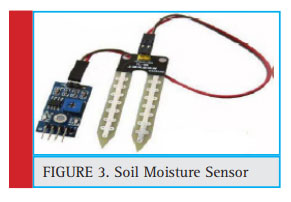 |
Figure 3 |
Relay
Relay, as shown in Figure 4, is used to control the water pump.
 |
Figure 4 |
Submersible pump
Figure 5 shows the Pump, which used to transmit water into soil.
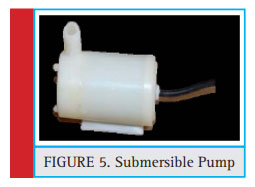 |
Figure 5 |
Jumper cables
Figure 6 shows the cables used to connect Arduino with sensors and relay.
Data logger shield
The data logger shield. as shown in Figure 7, is used with Arduino Uno for logging sensor data into Secure Digital card(SD).
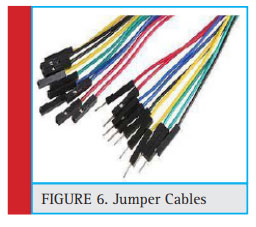 |
Figure 6 |
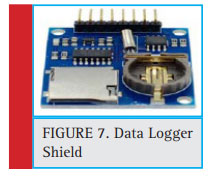 |
Figure 7 |
GSM SIM800L
The GSM SIM800L, as shown in Figure 8, is used with Arduino for sending text messages to homeowner’s mobile phone.
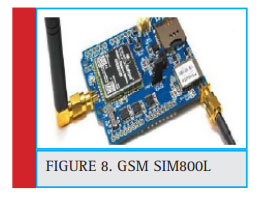 |
Figure 8 |
Water Flow Sensor
The water fl ow sensor, as shown in Figure 9, is used to measure the fl ow of water during the irrigation process. It consists of a plastic valve body, a water rotor, and a hall-effect sensor. Also, the water fl ow sensor has different measurements (water pressure (MPa) and fl ow rate (L/m)). In our study, we are concerned with the flow rate (L/m) measure.
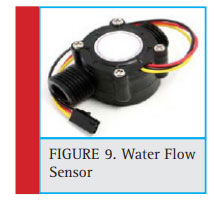 |
Figure 9 |
The block diagram in Figure 10 shows how the system’s components are connected. The Arduino is connected to the soil sensor through soil moisture sensor pins in a way that the VCC, GND, and A0 of the sensor are attached to 5V, GND, and pin A0 of Arduino respectively. The relay has three low voltage pins (-, +, and S) .These pins are connected to Arduino in order to operate or stop the pump according to the moisture value. The pump is connected with relay to pass water to the soil .Also we have used water fl ow sensor wires to connect them to the pump and Arduino (VCC to VCC, GND to GND, and pulse to D2) to measure the amount of water consumption during irrigation. GSM SIM800L pins are connected to Arduino for sending text messages to the homeowner informing him/her about the irrigation time and the amount of water consumption during irrigation. Where data logger is used to log data (soil sensor’s readings) to the text fi le for future use.
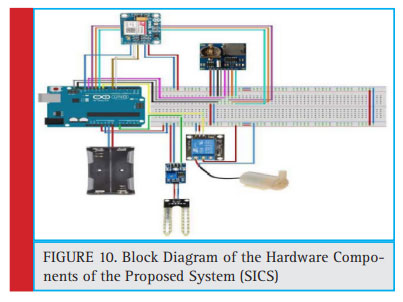 |
Figure 10 |
Arduino software IDE is used as our experimental platform since it uses a simplified version of C++, which makes it easier to learn and program.
System Design
In this part, we will walk through the key steps required to develop SICS.
Step1: Connect the soil sensor to Arduino via breadboard to monitor the Soil moisture continuously.
Step 2: Connect the GSM SIM800L to Arduino to send
text messages to the homeowner.
Step 3: Connect the data logger shield to Arduino via
breadboard to log the sensor’s data in the SD card.
Step 4: Connect the relay to Arduino via breadboard
and the pump to the relay to control the water.
Step 5: Connect the pump to the water fl ow sensor to
measure water flow.
Step 6: Connect the buttery to Arduino to increase
power supply.
Step 7: Connect Arduino to the PC to use the Arduino
interface.
Step 8: Download Arduino software from Arduino’s
official site to write the code.
Step 9: Write the code to implement the system.
Algorithm of SICS
Step 1: Initialize SD.
Step 2: Initialize (pumpRelayPin =0, sensor Pin=0,
sensor Value=0, pump Status = 0, watering Delay=1000,
sensor Pin W=2
Step 3: Read from the soil moisture sensor the moisture level
Step 4: Watered= False
Step 5: While soil moisture level < threshold value
Step 6: Start water pump to water the plant
Step 7: Watered=True
Step 8: Read from the soil moisture sensor the moisture level
Step 9: End While
Step 10: If Watered
Step 11: Notify the homeowner
Step 12: Read from water fl ow sensor the amount of
water passed in millilitres and save in data log
Step 13: Watered= False
Step 14: EndIf
Step 15: End
The system begins by checking the soil moisture level using the soil sensor. According to the level of the soil moisture, the system valve will turn ON or OFF automatically. Basically, the required level of the soil moisture of the planet will act as the threshold in our experiment. If the soil moisture is below the threshold value, then the water pump will start and a notification message will be sent to the homeowner. The threshold value is set according to the soil moisture level required for the plant. After reaching the required threshold value, the irrigation system will stop automatically
System Implementation
SICS was developed in two phases: the system hardware
development phase and the system software development phase.
A. System Hardware Development
Figure 11 illustrates how we connected Arduino to all
other hardware components in the system.
B. System Software Development Phase
First, we have included the libraries for the SD card and
Real-Time-Clock (RTC). Then we defined multiple variables for reading and writing from/to Arduino pins.
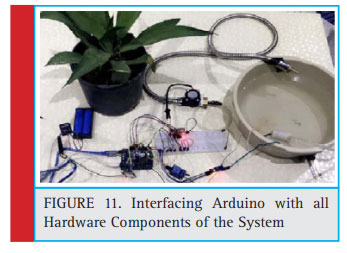 |
Figure 11 |
Soil Moisture Sensor Function
We take moisture readings from the soil via the soil sensor. Then, we map the output values from 0–100, since the moisture is measured in percentage. For instance, the soil moisture percentage that is required for the cactus plant is 90% (Jain, et al., 2016). The readings taken from the cactus dry soil were less than 90%, and in wet soil the readings were more than 90%. We compare the moisture reading with 90% and, based on the comparison result, the relay water pump will turn ON or OFF. Finally, the pump state will be printed on the serial monitor.
Water Flow Sensor Function
We use the water fl ow sensor to calculate the water consumption after completing the irrigation process. In order to determine how many milliliters of water passed through the sensor in a one-second interval, we divided the water fl ow rate by 60 and then multiply it by 1000.
Experimental results and Discussion
In order to conduct experiments and test SICS performance; we developed a mini garden of certain plants as shown in Figure 11.
Experiment 1
This experiment was conducted on two plants; rose and cactus. The season when the experiments were conducted was Spring and the temperature was around 33 °C. Table 1 illustrates the results of the experiment. According to a previous study (Jain, et al., 2016), the required soil moisture level for the rose plant is 40% and for the cactus plant is 90%. The observations in our experiment showed that the rose plant was watered daily and it required 1-4 liters per week, while the cactus plant was watered twice a week and required 2-3 liters per week. In addition, we noticed that the period of time that the irrigation system requires to pump sufficient water to the soil of the rose plant was 1-2 minutes whereas for the cactus plant it was five minutes. The state of both plants was good. By good we mean that the plant looks alive, hydrated and in a healthy manner without any defiiencies. We assessed the overall health status of the plant through observing the plant growth when the experiment was conducted for a period of five weeks. This experiment shows that the rose plant consumes more water than the cactus plant.
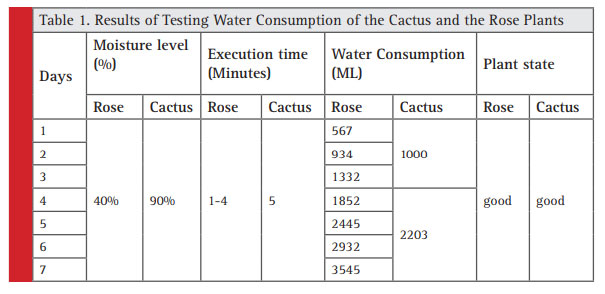 |
Table 1 |
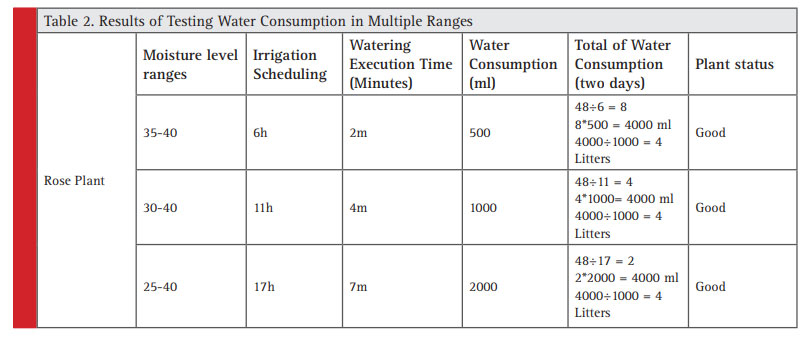 |
Table 2 |
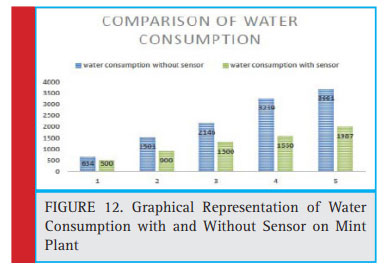 |
Figure 12 |
Experiment 2
This experiment was conducted on the rose plant and lasted for two days to measure water consumption under multiple sensor’s reading (as ranges) in order to determine the optimal range that saves water and plant. As mentioned earlier, the required soil moisture level for the rose plant is 40% (Jain, et al., 2016), therefore, when the soil moisture is under 40%, the water pump will start pumping water to irrigate the soil. The ranges that we tested were as follow: 35-40, 30-40, and 25-40. Table 3 demonstrates the results of the experiment. It was observed that in range 35-40, the time interval between two consecutive irrigation processes was six hours and the maximum amount of water consumed during irrigation was 0.5 liters. In range 30-40, the time interval between two successive irrigation processes was 11 hours and the maximum amount of water consumed
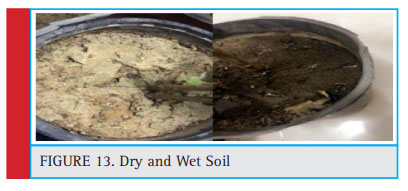 |
Figure 13 |
 |
Figure 14 |
during irrigation was 1 liter. Range 25-40 shows that the time interval between two irrigation processes was 17 hours and the maximum amount of water consumed during irrigation was 2 liters. Although the time interval between two consecutive irrigation processes was different in the tested ranges (6h,11h, and 17h), the water consumption of each irrigation process was different (500ml,1000ml, 2000ml respectively). However, there is no difference between the ranges in terms of the total amount of consumed water and plant status as shown in Figure 12. Therefore, none of the ranges was better than the others as all ranges eventually consumed the same amount of water (4000 ml) and the status of the plant was good in all cases
Experiment 3
For the sake of comparison and to clarify the impact of using SICS, our approach was compared to the automated irrigation approach, which relies on the irrigation timer. In order to perform the comparison, we collected the readings of water consumption (in millimeters) for each system for fi ve days on mint plant. It can be observed from Figure 12 that the automated system consumes more water. This means that SICS provides the appropriate amount of water by monitoring the level of the soil moisture. As such, there is no wasted water.
System Evaluation
Functional Testing
The aim of this testing is to assess the system behavior by evaluating the functionality of SICS and determining whether it is working (functioning) as expected or not. From the conducted experiments, we can say that SICS was able to sense the soil moisture, start watering the plant when needed, send a notification to the home owner, log the sensor data in the text file, determine the water consumption, and stop pumping water when the required soil moisture level is reached. To assess system reliability, SICS was tested in two different soil conditions (dry and wet) as shown in Figure 13. We observed that only in the case of dry soil the pump operates and the irrigation system starts watering since the soil sensor can determine if soil needs watering. Figure 14 shows the time series of the irrigation process before and after the system starts watering .
Conclusion And Future Work
The aim of our study was to design and develop a smart irrigation control system, which will further enhance the irrigation system in the KSA by optimizing water utilization, reducing the manpower, and providing an ideal environment for plants. SICS was successfully designed and tested. After conducting several experimental tests, we noticed that the system provides good results as expected, in terms of conserving the plants and watering them only when necessary by monitoring the amount of moisture in the soil. In addition, the system succeeded in quantifying the amount of water consumption through the irrigation process. As a result of our monitoring, we noticed that the plant maintained its balance in a desired, systematic and healthy manner without any deficiencies. For the future work, we plan to extend our experiments to include large areas of gardens with different plants. In addition, we would like to investigate and examine the behavior of the soil moisture sensor under salinity and fertilizer conditions. We also plan to use the readings collected from the soil moisture sensor as a reference for further development of new methods for the irrigation system, such as constructing a classification model for predicting soil status (dry or wet).
Acknowledgements
This work has been supported by a grant from the Research Center of the Female Scientific and Medical Colleges, Deanship of Scientific Research, King Saud University.
References
Siswazah, P. P., 2012. Universiti teknikal malaysia melaka. Framework, pp. 1-4.
Roy, D. K. & Ansari, M. H., 2014. Smart Irrigation Control System. 4(4), pp. 371-374.
Baig, M. B., Shayaa Al-Shay, M. & Straquadine, G. S., 2012.
Agricultural extension in the kingdom of Saudi Arabia: Diffi cult present and demanding future. Journal of Animal and Plant Sciences, 22(1), pp. 239-246.
Alkolibi, F., 2002. Possible effects of global warming on agriculture and water resources in Saudi Arabia: Impacts and responses. Climatic Change, 54(1-2), pp. 225-245.
Buechley, L. & Hill, B. M., 2010. LilyPad in the wild: how hardware’s long tail is supporting new engineering and design communities. Dis 2010, pp. 199-207.
Li, S., Xu, L. D. & Zhao, S., 2015. The internet of things: a survey. Information Systems Frontiers, 17(2), pp. 243-259.
Javed, A., 2016. Building Arduino Projects for the Internet of Things: Experiments with Real-World Applications. [Online].
Melorose, J., Perroy, R. & Careas, S., 2015. The Internet of Things: Do-It Yourself at Home Projects for Arduino, Raspberry Pi, and BeagleBone Black. s.l.:s.n.
Yao, Z., Lou, G., XiuLi, Z. & Zhao, Q., 2010. Research and development precision irrigation control system in agricultural. CCTAE 2010 – 2010 International Conference on Computer and Communication Technologies in Agriculture Engineering, Volume 3, pp. 117-120.
Chen, G. & Yue, L., 2011. Research of irrigation control system based on fuzzy neural network. 2011 International Conference on Mechatronic Science, Electric Engineering and Computer (MEC), Issue 1, pp. 209-212.
Chandak, P. P. & Student, M. T., 2017. Smart Farming System Using Data Mining. 12(11), pp. 2788-2791.
Suzuki, Y., Ibayashi, H. & Mineno, H., 2013. An SVM based irrigation control system for home gardening. 2013 IEEE 2nd Global Conference on Consumer Electronics, GCCE 2013, pp. 365-366.
Lad, H. J. & Joshi, V. G., 2014. Irrigation Control System using Distributed Embedded System. pp. 1336-1339.
Singh, S., Jha, R., Ranjan, P. & Tripathy, M. R., 2016. Software Aspects of WSN for Monitoring in an Indian Greenhouse. Proceedings – 2015 International Conference on Computational Intelligence and Communication Networks, CICN 2015, pp. 168-172.
Kabilan, N. & Senthamil Selvi, M., 2016. Surveillance and steering of irrigation system in cloud using Wireless Sensor Network and Wi-Fi module. 2016 International Conference on Recent Trends in Information Technology, ICRTIT 2016.
Jain, S. R., Kulkarni, A., Shaikh, A. & Sood, D. Y., 2016. Automatic Irrigation System for Agriculture Field Using Wireless Sensor Network (Wsn). International Research Journal of Engineering and Technology, pp. 2395-56.
Zhang, P. et al., 2017. The Construction of the Integration of Water and Fertilizer Smart Water Saving Irrigation System Based on Big Data. 22017 IEEE International Conference on Computational Science and Engineering (CSE) and IEEE International Conference on Embedded and Ubiquitous Computing (EUC), pp. 392-397.
Singh, P. & Saikia, S., 2017. Arduino-based smart irrigation using water fl ow sensor, soil moisture sensor, temperature sensor and ESP8266 WiFi module. IEEE Region 10 Humanitarian Technology Conference 2016, R10-HTC 2016 – Proceedings.
Kumar Sahu, C. & Behera, P., 2015. A low cost smart irrigation control system. 2nd International Conference on Electronics and Communication Systems, ICECS 2015, Issue Icecs, pp. 1146-1151.


